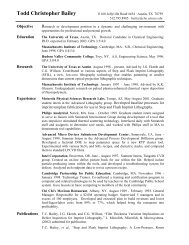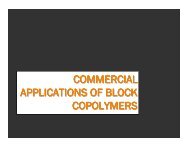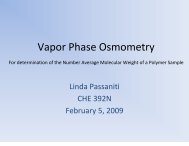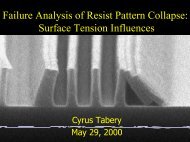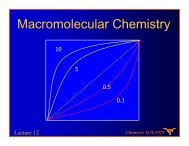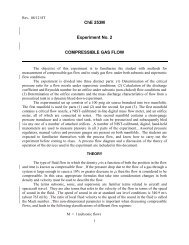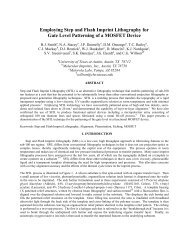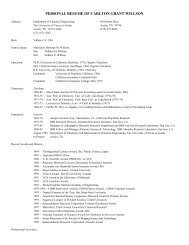Asymmetric fluid-structure dynamics in nanoscale imprint lithography
Asymmetric fluid-structure dynamics in nanoscale imprint lithography
Asymmetric fluid-structure dynamics in nanoscale imprint lithography
- No tags were found...
You also want an ePaper? Increase the reach of your titles
YUMPU automatically turns print PDFs into web optimized ePapers that Google loves.
Chapter 7: Clos<strong>in</strong>g Remarks7.1 SUMMARY OF RESEARCHThis research has encompassed a broad range of areas <strong>in</strong>clud<strong>in</strong>g analyticalmodel<strong>in</strong>g, numerical simulations, and experimental analysis. It has also<strong>in</strong>corporated a medley of software/hardware issues and spectral analysis. By<strong>in</strong>terpret<strong>in</strong>g the analytical models, numerical simulations, and experimentalresults, it has been shown that the Reynolds equations for squeeze film damp<strong>in</strong>gis a valid and useful tool for understand<strong>in</strong>g the <strong>dynamics</strong> of the mechanicalsystems <strong>in</strong> SFIL.The <strong>fluid</strong> pressure plays a significant role to orient the passively compliantstages used <strong>in</strong> the multi-impr<strong>in</strong>t stepper and the s<strong>in</strong>gle impr<strong>in</strong>t mach<strong>in</strong>es. It hasbeen shown that the pressure tends to correct the angular misalignments bygenerat<strong>in</strong>g a damp<strong>in</strong>g torque and the pressure asymmetry cannot be ignored.Thus, the orig<strong>in</strong>al <strong>in</strong>tent of the passive stage designs has been proven to work.The passive stages self-correct due to the coupl<strong>in</strong>g between the mechanicalsystem and the liquid etch barrier. Although presence of the etch barrier aides <strong>in</strong>correct<strong>in</strong>g the misalignment, it also limits the rate at which impr<strong>in</strong>t<strong>in</strong>g can bedone s<strong>in</strong>ce, th<strong>in</strong>ner base layers require more time to achieve. However, with anappropriate control scheme, based on a two s-curve motion profile, this problemcan be solved. Furthermore, the theoretical and measured forces can be achievedby the actuation systems currently implemented.An additional contribution of this research work has been the applicationof a real-time gap-sens<strong>in</strong>g tool <strong>in</strong> measur<strong>in</strong>g the film thickness of the <strong>fluid</strong> dur<strong>in</strong>gthe squeez<strong>in</strong>g process. In develop<strong>in</strong>g an active stage system to perform SFIL, this99



